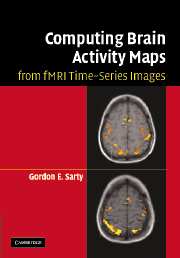2 - Image preprocessing
Published online by Cambridge University Press: 07 December 2009
Summary
fMRI time-series contain a number of systematic sources of variability that are not due to the BOLD effect of interest. These sources of systematic variability may be removed as a preprocessing step, as outlined in this chapter, or they may be removed as a covariate at the time of activation map computation. The sources of variability include factors due to the physics of MRI, subject motion, heart beat and breathing, other physiological processes, random thermally generated noise and intersubject anatomical variability. The variability due to the physics of MRI include ghosts, geometric distortion and some signal drift which (with the exception of drift) may be removed at the pulse sequence and image reconstruction level. However, such ideal pulse sequences are not yet widely available on commercial scanners and many investigators must simply accept compromises, such as the geometric distortion of EPI images. A small amount of subject motion can be compensated for by aligning the time-series fMRI images but motion may also be dealt with at the source by using suitable restraining devices and training the subject to hold still (mock MRIs are very useful for training study subjects in this respect). It is impossible to remove the source of physiological variables so these need to be corrected at the time of data processing. Two approaches are used to remove physiologic effects from the data: one is to model heart beat and breathing, the other is to measure and remove the effect of a global signal. Again, many investigators do not account for non-BOLD physiologic variation at the expense of reduced statistical power to detect BOLD activations.
- Type
- Chapter
- Information
- Publisher: Cambridge University PressPrint publication year: 2006



